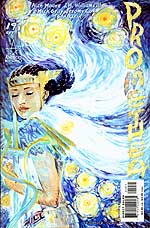 "Promethea" #19
"Promethea" #19 |
With her pupil-less eyes, brass breastplate and art-deco winged headpiece, Promethea looks like a combination of Wonder Woman and a 1930s Chrysler hood ornament. Set in a world very like our own, but slightly more technologically advanced — they have hover cars and science villains like "Jellyhead" — Promethea appears when Sophie Bangs, a poetically precocious teenager, channels her from out of the world of imagination. During the first twelve issues Promethea discovers she is the latest in a long line of Prometheas, all of whom materialize through works of an artist. Mixing typical superhero fisticuffs with darker themes of mortality and sex, plus a soupcon of silly English humor, "Promethea" became one of industry's best genre titles.
The second major arc began at issue 13, when Promethea decides she must follow her recently-deceased friend into the afterlife. It's no coincidence that this new arc begins at this loaded, occult number. Readers of Alan Moore's recent work, most notably "From Hell," have gotten used to his fascination with the connections between physics and metaphysics. For this journey Promethea follows the Kabbalah, AKA "The Tree of Life," a Hebrew glyph of ten interconnected numbers laid out like a hopscotch pattern. Dedicating one issue to each "sephiroth," or number, Moore imagines each one as a real place corresponding to a part of our solar system, an aspect of divinity, and a card in the tarot deck. As Promethea travels to each realm she learns more and more about the nature of man and divinity.
 A typically fascinating two-page spread from "Promethea"
A typically fascinating two-page spread from "Promethea" |
Where most conventional superhero books present some sort of evil to be overcome, this series depicts the overcoming of reality. This narrative requires a different, refreshing way of reading a "superhero" book. It's more like one of those smart travelogues that doubles as an essay. "We're in the mercurial realm of language, magic and intellect. It's Hebrew name is 'Hod.' That means splendor," is a typical bit of sometimes overly-didactic dialogue. Moore delights in revealing how everything ties together, sometimes leaving the reader feeling lectured. Even so, he is enough of a storyteller to never let us go too long without some adventure. Issue 16 has Promethea perilously sink to the bottom of a literal ocean of emotion. In issue 18 she slips into the anti-Kabbalah system of Qlippoth where she encounters the demon Asmodeus. In this world of rage and hate, he appears to her as a giant spider. Then, with a typically clever bit humor, once Promethea gets a hold of herself and apologizes for intruding, Asmodeus changes into a English fop.
Beyond Moore's fascinating story, the Kabbalah series represents a tour de force of studio comix making. J.H. Williams III does the underlying pencils, filling the panels with surreal details like walls that have bricks standing up on little legs and extracting themselves. One of the hallmarks of the entire "Promethea" series has been the consistently innovative and fun layouts. One double-page spread has Promethea endlessly looping around a Mobius strip. For this particular arc Williams had a new challenge: imitating wildly divergent mediums, from engraving to wood carving to watercolor with nearly entire issues dedicated to one motif or another. Each cover is also an homage to a different artist both high (Vincent van Gogh) and low (Frank Frazetta). On top of these pencils Mick Gray's expert inks move from dramatically heavy, but never muddy, to delicately ethereal, as the scene requires. The coloring, by Jeromy Cox, likewise has issue-length themes, from aquatic tones to grey wash to red and ultimately heavenly white and gold. Lastly, yes, even the letting, by Todd Klein, deserves kudos for its clarity and variety.
With this ten-issue series of "Promethea" Alan Moore, J.H. Williams III, et. al, have transcended the dull routine of ordinary comicbooks, just as the heroine transcends the lowest "sephiroths" of the Kabbalah. Through ingenuity of form and a willingness to travel to new places, "Promethea" reaches for the heavens.
"Promethea" can be found at any comic store. Strangely tardy, DC Comics plans on collecting issues 7-12 into a paperback in December. Issues 13-23 have no collection date, but the individual issues can likely be found at comic stores with a decent backstock.
